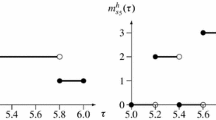Abstract
We describe a homotopy algorithm for the computation of equilibriain Stochastic Finance Economies. The algorithm solves a nonlinearsystem of equations consisting of the first-order conditions of theagents' utility maximization problems and market-clearing conditions.Moreover, we discuss the use of a straightforward homotopy approach for localcomparative statics. Using our methods we evaluate price, volatility,and welfare effects of options in incomplete asset markets.
Similar content being viewed by others
References
Brown, D.J., DeMarzo, P.M., and Eaves, B.C. (1996). Computing equilibria when asset markets are incomplete, Econometrica, 64, 1-27.
Chamberlain, T.W., Cheung, S.C., and Kwan, C.C.Y., (1993). Options listing, market liquidity and stock behaviour: Some Canadian evidence, Journal of Business Finance and Accounting, 20, 687-698.
Conrad, J. (1988). The price effect of option introduction, The Journal of Finance, 44, 487-498.
Cottle, R., Pang, J., and Stone, R. (1992). The Linear Complimentarity Problem, Academic Press, San Diego.
Detemple, J. and Jorion, P. (1990). Option listing and stock returns: An empirical analysis, Journal of Banking and Finance, 14, 781-801.
Detemple, J. and Selden, L. (1991). A general equilibrium analysis of option an stock market interaction, International Economic Review, 32, 279-303.
Dold, A. (1980). Lectures on Algebraic Topology, Springer-Verlag, New York.
Duffie, D., Geanakoplos, J., Mas-Colell, A., and McLennan, A. (1994). Stationary markov equilibria, Econometrica, 62, 745-781.
Duffie, D. and Shafer, W. (1985). Equilibrium in incomplete markets I: A basic model of generic existence, Journal of Mathematical Economics, 14, 285-300.
Elul, R. (1995). Welfare effects of financial innovations in incomplete markets with several consumption goods, Journal of Economic Theory, 65, 43-78.
Garcia, C. and Zangwill, W. (1981). Pathways to Solutions, Fixed Points, and Equilibria, Englewood Cliffs, Prentice Hall.
Hernandez, A. and Santos, M.S. (1996). Competitive equilibria for infinite-horizon economies with incomplete markets, Journal of Economic Theory, 71, 102-130.
Heaton, J. and Lucas, D.J. (1996). Evaluating the effects of incomplete markets on risk sharing and asset pricing, Journal of Political Economy, 104, 443-487.
Huang, P. and Wu, H.M. (1997). General equilibrium with incomplete markets of European options, working paper, Stanford University and National Taiwan University.
Judd, K. (1997). Computational economics and economic theory. Substitutes or complements? Journal of Economic Dynamics and Control, 21, 907-942.
Judd, K. (1998). Numerical Methods in Economics, MIT Press, Cambridge.
Judd, K. and Guu, S.-M. (1996). Bifurcation methods for asset market equilibrium analysis with small risks, working paper, Hoover Institution, Stanford University.
Judd, K., Kubler, F., and Schmedders, K. (1997). Incomplete asset markets with heterogeneous tastes and idiosyncratic income, working paper, Hoover Institution, Stanford University.
Kirman, A.P. (1992). Whom or what does the representative individual represent? Journal of Economic Perspectives, 6, 117-136.
Krasa, S. (1989). Existence of competitive equilibrium for option markets, Journal of Economic Theory, 47, 413-421.
Kubler, F. (1994). Der Preiseffekt einer Optionseinführung auf den Preis der unterliegenden Aktie, Diplomarbeit, Rheinisch-Westfälische Friedrich-Wilhelms-Universität, Bonn.
Long, D.M., Schinski, M.D., and Officer, D.T. (1994). The impact of option listing on the price volatility and trading volume of underlying OTC stocks, Journal of Economics and Finance, 18, 89-100.
Lucas, R., Jr. (1978). Asset prices in an exchange economy, Econometrica, 46, 1429-1445.
Magill, M.J.M. and Quinzii, M. (1996). Theory of Incomplete Markets, MIT Press, Cambridge.
Polemarchakis, H. and Ku, B. (1990). Options and equilibrium, Journal of Mathematical Economics, 19, 107-112.
Pope, P.F. and Yadav, P.K. (1992). The impact of option expiration on underlying stocks: The UK evidence, Journal of Business Finance and Accounting, 19, 329-344.
Powell, M.J.D. (1970). A hybrid method for nonlinear equations, In P. Rabinowitz (ed.), Numerical Methods for Nonlinear Algebraic Equations, Gordon and Breach, New York.
Ross, S.A., 1976, Options and efficiency, Quarterly Journal of Economics, 90, 75-89.
Schmedders, K. (1996). Damped asset trading in the general equilibrium model with incomplete asset markets, Technical Report 96-11, Department of Operations Research, Stanford University.
Schmedders, K. (1998). Computing equilibria in the general equilibrium model with incomplete asset markets, Journal of Economic Dynamics and Control (forthcoming).
Schnabel, R.B. and Frank, P.D. (1984). Tensor methods for nonlinear equations, SIAM Journal on Numerical Analysis, 21, 815-843.
Shoven, J.B. and Whalley, J. (1992). Applying General Equilibrium, Cambridge University Press, Cambridge.
Watson, L.T. (1979). A globally convergent algorithm for computing fixed points of C2 maps, Applied Mathematics and Computation, 5, 297-311.
Watson, L.T., Billups, S.C., and Morgan, A.P. (1987). HOMPACK: A suite of codes for globally convergent homotopy algorithm, ACM Transactions on Mathematical Software, 13, 281-310.
Watt W.H., Yadav, P.K., and Draper, P. (1992). The impact of option listing on the underlying stock returns: The UK evidence, Journal of Business Finance and Accounting, 19, 485-503.
Author information
Authors and Affiliations
Corresponding author
Rights and permissions
About this article
Cite this article
Kubler, F., Schmedders, K. Computing Equilibria in Stochastic Finance Economies. Computational Economics 15, 145–172 (2000). https://doi.org/10.1023/A:1008651229355
Issue Date:
DOI: https://doi.org/10.1023/A:1008651229355




